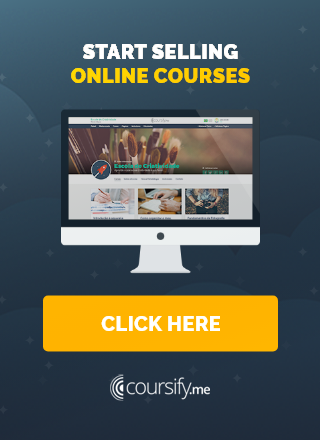6 tips to make your online courses even better
Do you create GREAT online courses or just good enough? With the eLearning market going through a phase of strong expansion, competition has increased significantly, and it is not time to play around.

Strategies to improve your online courses and attract more students
The COVID-19 pandemic closed schools and highlighted distance education as the only way to continue teaching.
Several educational institutions, from elementary to higher level, were forced to rethink their way of teaching, and those who were not yet familiar with the use of technology in education, had to run to keep up.
– Tips for using elearning in school education
Apart from the school situation, with the new rules of social isolation, many economic activities were in trouble, and thousands of professionals had to reinvent themselves to continue working.
Thus, activities that could be carried out from home gained more prominence than ever, which generated a huge increase in the demand for online courses.
– 10 profitable niches for online courses
However, despite being qualified professionals in their field, few are familiar with the processes and resources needed to create online courses, and the vast majority fail in some basic aspects of its development.
To improve your online courses and thereby increase the demand for them, we have listed six characteristics that excellent courses have. Check out!
1. General and specific goals
Have you ever watched a movie just to get to the end and ask yourself why you wasted hours of your life with that? The kind of movie that doesn’t seem to even have an ending and you don’t even remember what it meant in the first place?
That’s right, this is a risk that your online course runs, if you start to develop it without a clear objective and a well laid out plan.
Having a goal helps to shape the way you provide instructions so that there is less guesswork or confusion.
To determine the purpose of your course, start by identifying what is your highest priority. For example, “I want to teach about creative writing”. Great, you have a general goal, now you need to break it down into specific objectives that will serve as guidelines for the construction of the course curriculum.
Going back to the previous example, think about what your student needs to know in order to develop their creative writing. He will have to learn about building plot, characters, figures of speech, style, etc.
All of these topics are small goals that lead to a bigger one, and need to be overcome in a logical, organized way, so that the student can follow and understand the subject.
So, before you start creating online courses, sit down, outline your goals and plan in detail how you will pass your knowledge on to someone else.
– Step by step to plan your online course
2. Correct use of resources
A common mistake among those who start creating online courses, is to think that it is enough to digitize printed materials, in order to “convert” what is used in a traditional classroom for digital format.
Really excellent e-courses consider how people learn, and not just gather and deliver information, hoping they will turn around to assimilate that.
Take advantage of technology to bring natural forms of learning to the digital arena, making teaching more efficient and attractive.
Here are some ways to do this:
- Use different resources with balance: There are a variety of elements that you can use to engage students, including images, videos, audios, slides, among others. However, use these elements to improve the information, not overload it. Clarity in communication is essential in online education.
- Use visual aids that support the goals: Pay attention to what works best to explain each subject in your course and focus on that. When you’re not sure if a chart helps or hinder your goal, it’s usually best to leave it out.
- Function instead of style: Spending too much time in the appearance of your course before making sure that the basics are done well, can result in small mistakes, but that attract attention and convey an image of amateurism, such as inappropriate style choices , spelling errors, revision failures, among others. So, even if you have decided that a Flash introduction is what your course needs, start by ensuring that what really matters to learning is flawless.
- Get to know your students: Before deciding on how many graphics will be on your slides, take the time to get to know your audience. It is extremely difficult to involve someone you don’t know. It would be like trying to get a person’s attention in a crowded store without even knowing their name. Understand who your audience is, what they are looking for and what type of communication works best for them.
– See 3 ways to validate your online course
3. Relevant and targeted content
Your students are like customers of any company, if you don’t show them something they want, they won’t be motivated to buy it.
As in the development of any product / service, great online courses need to use tools to get to know their customers so they can sell more assertively to them.
Creating relevant and targeted teaching content involves:
- Shaping your message in a way that interests and captures the attention of your target audience.
- Choose the appropriate information, find the most effective instructional strategy, select the right media to get the message delivery.
- Review the learning objectives during the design phase. This ensures that your content is relevant and that there is no information that is not directly related to the course goals.
Formal and informal research lets us know what our target market is looking for and what is important to them. Your online courses must be built around these needs.
If it appears that there are two or more distinct groups in your audience, it may make sense to create multiple versions of your content. Each one can focus on a different need to ensure that you serve everyone and thereby expand your business opportunities.
– 4 Tips to prepare a satisfaction survey for online courses
4. Communication logic
No matter how sophisticated your presentation is, if it isn’t easy for the students to follow your course.
The content and navigation need to flow in a logical pattern so that the public can spend more time retaining the message, rather than trying to figure out which button to press or understand what this lesson has to do with the previous.
Likewise, writing in a course should never be overlooked. Your text should be appropriate for the audience, not too simplified or complicated for your purposes and skills.
Another reason why it is so important to know your audience. The material offered must correspond to their skills and speak their language. There is no point in using erudite language with a very young audience, nor requiring more advanced knowledge from those who are still learning the basics.
If this happens, your students will be frustrated, with a sense of wasted time, and will hardly return to the next class.
– How to improve communication with the student
5. Call to action
Great online courses are always interesting, they take students’ engagement and use it to get them into action.
Your words need to work together with visual elements to be inspiring, persuasive and actionable.
You want your students to be able to DO something not only during the course, but also after completing it. After all, an excellent online course is one that generates positive changes in the student’s life.
To do this, you need to bring your course to real life, where people can set goals, plan, think about the information they have acquired and how they can do something with them.
Incorporate calendars, scorecards and other goal setting elements in your course to engage them.
Here are some other ideas:
- Incorporate practical exercises similar to what students are expected to do in the workplace. For example, in a course for call center employees, create activities such as answering phone calls following tips from scripts and templates. These hands-on exercises give the course a practical look that is highly regarded by people looking for online courses as a way to professionalize and improve the curriculum.
- Show the immediate rewards of mastering certain knowledge, for greater engagement. Remember that most people need to see in order to believe and get excited. If students see the real benefit or immediate reward of completing the course in advance, they will likely endeavor to do so.
- Answer these questions to your students: What will they gain? What will they be able to do? If you cannot answer for them, there are likely to be non-engaged or dropout students.
– How to Build a Successful Distance Learning Course
6. Instructional Design
Distance learning projects are methodical and strategic; they have a solid instructional design strategy.
This means that they understand what we mentioned at the beginning, that it is not enough to digitize printed materials and make content available in any way.
Instructional design is concerned with building online content so that it is read and understood in the best way.
It’s the approach by which your eLearning course will be developed to engage students.
Doing things right leads to better learning outcomes, and this is what we need to provide when someone invests their time and money in our courses.
There are a variety of approaches that instructional designers can take, including narrative, discovery learning, situational learning and many others.
When deciding on a strategy, consider the following factors:
- Type of content: What is the best way to teach a particular subject? A video tutorial or a detailed analysis using graphics, for example?
- Impact: What is the best way to make this lesson meaningful and relevant?
- Objectives: How can I ensure that each student will master the objective?
- Activities: Did you select the best activities to achieve the desired results? Create and organize activities that are relevant, attractive, give credibility to the course and truly contribute to facilitate learning.
– Record tutorial videos: tips to get the best result
Remember: When students believe that what they are doing is a valuable learning experience, which can bring changes to their lives, they become more involved and accept knowledge you’re offering more easily.
Build your online courses on Coursify.me

Much of what we learn about passing on information to others can easily be overlooked when we get involved in the various stages of creating online courses.
However, keeping these six main points in mind is a good start to achieving goals and helping your students achieve results.
Complete eLearning platform, Coursify.me is the ideal solution for anyone who wants to create, sell and advertise courses on the internet.
Serving companies and professionals in more than 60 countries, the platform is a dynamic and customizable Learning Management System.
– Whats is a Learning Management System
Coursify.me offers three plan options for you to decide which best suits your needs and the good news is that the Starter Plan is free!
To learn more,visit our website, test the platform, and start creating successful online courses right now.

